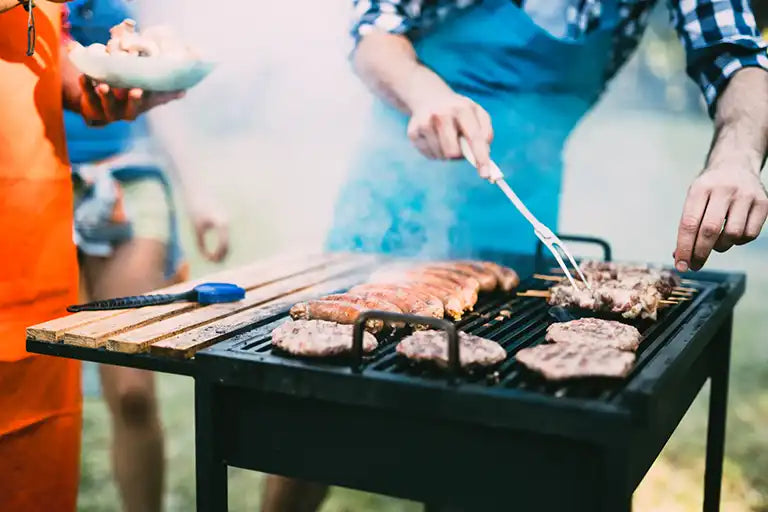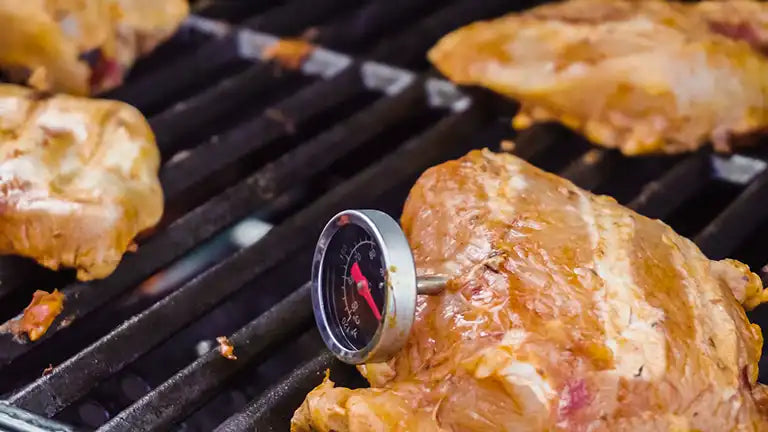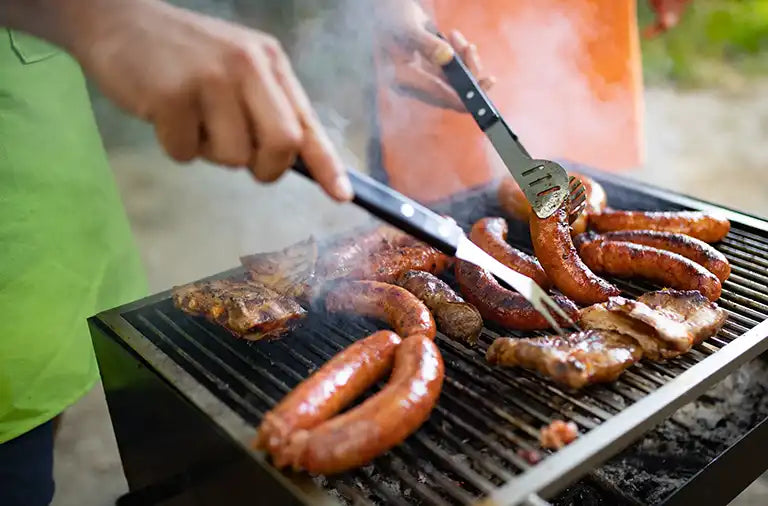The right cooking times for meat are crucial for the perfect grilling result. If the meat is on the grill for too long, it will become dry and tough. If it is grilled for too short a time, however, it may remain too raw. Various factors play a role in determining the ideal cooking time: grilling method, core temperature and the meat itself. We have the right solution.
Cooking times for meat: Cook pieces of meat on the grill until juicy

It doesn't matter whether it's beef, pork, lamb or poultry. The type of meat determines the type of preparation. Direct or indirect grilling is used depending on personal preference. If the meat is to cook slowly, indirect grilling is recommended. For quickly fried pieces: direct grilling. A core temperature measuring device is necessary to achieve the perfect degree of doneness. The correct use of the core temperature measuring device is important for the best result. The temperatures vary depending on the type of meat.
Direct or indirect grilling
Direct grilling means that the meat is placed directly over the heat source (e.g. coals, gas grill burners). Here the meat is immediately exposed to intense heat, which gives it a wonderfully crispy crust. This is not only important for the characteristic grill aroma, but also keeps the meat nice and juicy on the inside. Direct grilling is therefore particularly suitable for quick-fried foods such as steaks or sausages .
With indirect grilling, the preparation time for the food is longer. Here, the food is not placed directly over the heat source, but at a sufficient distance from the embers or burner. The effect is similar to that of circulating air in an oven: the heat acts more slowly and evenly on the meat, which ensures a buttery-soft consistency. This also makes it possible to cook for longer without the cut of meat burning. Indirect grilling is ideal for larger pieces of meat such as roasts , whole roast chickens or ribs .
Even though the two types of grill are better suited to different types of meat, they can also be combined well. Many experts sear the meat on the grill directly over the heat and then let it continue to cook gently in the indirect area until it has reached the right cooking point and the optimal core temperature .
The core temperature when grilling
The best indicator of the optimal cooking point is the core temperature. This can be measured during the cooking process with a meat thermometer and is important for various reasons: Firstly, it tells you whether the meat is safe to eat, i.e. no longer raw. Secondly, it tells you whether the steak is pink, medium or well done on the inside.
Depending on the type of meat and the desired cooking point, there is a different optimal core temperature . For example, a roast chicken should have a core temperature of at least 75 °C, while a beef steak served medium rare should ideally have a core temperature of 47 °C. When the temperature is reached and the cooking is finished also depends on the meat.
How to use a grill thermometer correctly
To ensure the correct use of a thermometer , it is important to understand the different types of measuring devices. When measuring the core temperature, a meat thermometer is indispensable. It allows you to determine the exact temperature of the meat and ensure that it is optimally cooked. To determine the cooking chamber temperature, an oven thermometer is of great importance. It helps you to keep the temperature in the oven constant and ensure that your food is cooked evenly. When using a thermometer, it is important to position the thin needle and its probe tip correctly during the cooking process. This should be inserted into the food to enable an accurate measurement. Be careful not to insert the probe too deeply or too superficially, as this will lead to inaccurate results.
What is the core temperature
The core temperature is the temperature in the middle of the food at the thickest part of the meat . Correct use is the key to perfectly cooked food. By measuring the core temperature, you can ensure that your meat is juicy and tender without being raw or overcooked. A meat thermometer gives you the certainty that your roast , steaks or poultry have reached exactly the right temperature. The cooking chamber temperature is of great importance in order to achieve an optimal result. It is also helpful when baking. With an oven thermometer, you can ensure that the temperature remains constant throughout the entire baking process and that cakes, tarts or casseroles are cooked perfectly.
Be aware of the importance of the probe tip when using a thermometer. By placing it correctly, you can get an accurate and reliable reading. When inserting the probe, use gentle but firm, consistent force. Make sure the tip reaches the center of the food without hitting the bottom of the container.
Overall, the correct use of your gadgets is crucial to achieving perfect results in the kitchen, so be patient and precise when using your measuring device to ensure your food is always cooked to perfection .

Particularly juicy even without technical aids
For those of you who are more experienced with grilling, we can give you a helpful tip. During the various cooking stages from rare to well done , we are in what is known as a plateau phase. The individual components of the muscle protein coagulate. This causes the cell walls to burst and release the cell juice. The meat starts to cry and the juice gradually increases. With a little experience and in conjunction with checking the pressure, you can use this to determine the exact cooking time and core temperature of the piece, regardless of the method of preparation. Here you can find out more about cooking without technical aids.
The correct cooking time depends on the type of meat
Only with the right length of time can the meat develop its full flavor potential and become a culinary grilled delight. This varies not only depending on the type of meat, but also on the thickness of the piece of meat and the cooking method, such as roasting in the oven. The following rule applies: the thicker or larger the piece of meat, the longer it takes. The following overview provides a good guide to the optimal cooking times for grilled meat:
beef
A whole cow can be used to make a variety of different cuts , each with its own character but with different cooking time and temperature requirements. Every steak needs strong, direct heat to develop a delicious crust. Depending on personal preference, the meat inside can vary from rare to medium to well done . The corresponding core temperatures (CT) are as follows.
Recommended cooking time for approx. 2 cm thick steaks (rib-eye, T-bone, fillet, loin):
Rare (up to 80%): Grill directly for 1-2 minutes per side, then let rest for 6-8 minutes, internal temperature 44 - 48 °C
medium rare (up to 50% rare), grill directly for 2 minutes per side, then let rest for 6 to 9 minutes, internal temperature 49 - 53 °C
Medium (rare up to 20%): grill directly for 3 minutes per side, then let rest for 4 minutes, internal temperature approx. 54 - 57 °C
Medium well (pink inside, but still juicy) KT approx. 60 - 64 °C
Well Done: Grill directly for 4-5 minutes per side, then let rest for 1 minute, core temperature 65 - 68 °C
Roasts and other larger pieces of meat, on the other hand, should not be grilled directly over the fire, so that they are cooked evenly over a long cooking time and become tender and juicy on the inside.
Example: Cooking time for beef roast from the prime rib, boned (2.5 kg)
Medium Rare: approx. 75-90 min, KT < 50 °C
Medium: approx. 90-105 min, KT approx. 55-60 °C
Well Done: approx. 105-120 min, CT > 70 °C
pork
Pork steaks and chops are usually better suited to direct grilling, as this makes them crispy on the outside. They need around 4 - 6 minutes per side and should reach a core temperature of 60 - 64 °C. Spare ribs , roasts and meat for pulled pork, on the other hand, get their special juiciness from indirect heat, which is usually at lower temperatures. Depending on the cooking chamber temperature, it takes between 45 minutes and 6 hours for spare ribs to reach the optimal core temperature of 85-90 °C, for roasts it can take 1.5 to 3 hours, and for pulled pork it can often take between 3 and 6 hours.
poultry
Poultry is often a challenge to prepare. It has to be cooked evenly without becoming dry. This is especially true for chicken breasts , but also chicken legs , which are grilled directly. Whole roast chickens, on the other hand, benefit from indirect grilling with a longer cooking time. Tip: Brush them regularly with marinade or stock to give them a particularly crispy crust.
Poultry (e.g. chicken):
Chicken breast (boneless): approx. 15-20 min
Chicken breast (with bone): approx. 30-35 min
Chicken leg: approx. 25-35 min
whole roast chicken (approx. 1-1.2 kg): approx. 50-60 min, core temperature approx. 80 °C in the legs
lamb
Similar to beef and pork, direct grilling is recommended for lamb chops and lamb loins . Leg of lamb, on the other hand, should be grilled indirectly.
Lamb:
Lamb chop: approx. 5-6 minutes per side
Lamb salmon: approx. 2 minutes per side
Leg of lamb (approx. 1.5-2 kg): 60-70 min, core temperature (medium) approx. 70-72 °C
Bratwurst & Co.
Whether it's a classic Franconian bratwurst , red beer bratwurst , Merguez or Cheesy Gonzales : sausages of all kinds are traditionally grilled straight away . But be careful with the cooking time: if they're on the grill for too long, the skin can burst and the juice can leak out, making them dry.
Bratwursts (turn occasionally):
boiled sausages (70-120 g): approx. 8-10 min
raw sausages (70-100 g): approx. 10-15 min
raw sausages (100-120 g): approx. 15-20 min

Tips and tricks to help you achieve the perfect cooking times for grilled meat
1. Preheat the grill so that the food starts cooking immediately when it is placed on the grill.
2. Take the piece of meat out of the refrigerator early and grill it at room temperature so that it cooks more evenly.
3. Do not turn too often, once is usually enough.
4. Use grill tongs to turn the steak or roast instead of stabbing it with a fork.
5. For larger pieces of meat, use a meat thermometer to measure the core temperature.
6. Allow the grilled food to rest briefly before cutting.
The cooking times given are guidelines that provide a good orientation. In individual cases, they can vary depending on the type of meat, thickness and personal preferences. That's why experimenting is expressly encouraged and necessary in order to be able to correctly estimate the core temperatures and cooking times of meat over time.
Do you have any further questions?
Cooking times and core temperatures can vary greatly depending on the cut of meat and the desired level of doneness . There is no one-size-fits-all rule here, as the ideal cooking time also depends on the type of meat and its thickness. As a general guideline , however, beef needs a core temperature of 54-56°C for medium, while poultry should reach a core temperature of at least 70°C to be safely cooked through. It is always advisable to have a meat thermometer on hand to determine the ideal cooking time.
The correct temperature for cooking meat can vary greatly and depends on the type of meat , its size and the desired degree of doneness. As a general guideline , however, beef should be cooked at core temperatures of 54-57°C for medium-rare and 70-77°C for well done. Poultry should generally be cooked to a core temperature of at least 75°C to ensure that any pathogens present are killed. For other types of meat such as pork or lamb , the recommended cooking times and core temperatures are in a similar range.
Cooking times for meat at 180 degrees will vary greatly depending on the specific type of meat and its thickness. Typically, you would cook a piece of beef for around 15-20 minutes per 500g, aiming for medium doneness . Poultry may need a little longer, for example a whole chicken might need 1.5 - 2 hours. It is always advisable to use a meat thermometer to check the core temperature and ensure the meat is cooked properly.
The cooking time for meat at 200 degrees can vary greatly depending on the type of meat and whether it is being grilled directly or indirectly. Beef, for example, typically takes about 15 minutes per pound at this temperature, while poultry may take longer. It is important to monitor the internal temperature to ensure that the meat is cooked properly. A meat thermometer is a useful tool for this.
The cooking time for meat at 150 degrees varies depending on the type of meat and the size of the cut. However, as a general guideline , beef will take about 1 to 2 hours, poultry 1.5 to 2 hours and lamb 1 to 1.5 hours. It is important to use a meat thermometer to check the core temperature and ensure that the meat is properly cooked.
Depending on the type of meat, we recommend using indirect or direct grilling. However, it is also possible to use both types of grilling for the meat. It all depends on personal preference. To be sure what temperature the meat should be at, we recommend using a core temperature gauge. This device ensures that the optimal degree of doneness can be achieved and that the meat remains tender and juicy. A distinction must be made between beef, lamb, pork and poultry. A distinction must also be made as to whether the meat is being prepared as a roast or as a classic steak. In general, anything from rare to well done is possible. Personal preference determines the length of preparation and the core temperature of the meat. If the meat is to cook slowly, then indirect grilling is recommended. Quick-fried pieces should be grilled directly.

